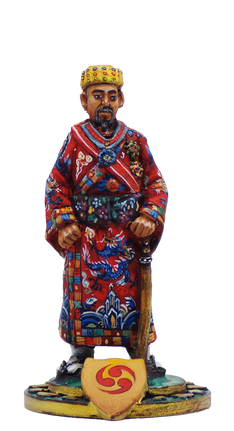
Sho Ten
Prince of Nakagusuku
Marquess Sho Ten (2 September 1864 – 20 September 1920) was the last crown prince of the Ryukyu Kingdom (Nakagusuku Oji, lit. Prince of Nakagusuku). He lost that title upon the abolition of the kingdom and the forced abdication of the king, his father, Sho Tai, in 1879, and later succeeded to the title of Marquess (koshaku) in the kazoku peerage following his father's death in 1901. Sho Ten was born in Shuri and was from birth crown prince to the Ryukyu Kingdom. He underwent his coming-of-age ceremony in 1878 and was married the same year. In March 1879, his father Sho Tai formally abdicated upon the orders of the Meiji government, which abolished the kingdom, transforming Ryukyu domain into Okinawa Prefecture, with officials appointed from Tokyo to administer the islands. The former king was ordered to report to Tokyo, but feigning illness, he temporarily found shelter at his son's palace. Sho was then sent to Tokyo as a hostage and partial appeasement as Ryukyuan officials searched for ways to delay the former king's departure. Following his father's death and his succession as Marquess and head of the Sho family in 1901, Sho and his family gave up the trappings of traditional Ryukyuan royal court life, costume, court language, and ritual, and adopted those of the Japanese peerage. As Marquess, Sho held a hereditary seat in the House of Peers in the Imperial Diet. He was joined in representing Okinawa by a Japanese resident

appointed to represent the prefecture's wealthiest taxpayers for the first time in 1918. Sho died on 20 September 1920, in his mansion in Shuri and was entombed six days later in Tamaudun, the royal mausoleum near Shuri Castle, in accordance with traditional Ryukyuan royal funerary rites. He would be the last member of the Sho family to be honored in such a manner.

The Ryukyuan military hierarchy was a top-down chain of command, with the king at the top. Below the king was the Sanshikan, a government body of his three most trusted advisors. There were three "Watches" (ban), each of which composed of four hiki, that guarded the Shuri-Naha area. Historian Gregory Smits concludes that the Sanshikan originated from the commanders of the three Watches. In addition to the Watches, each magiri had forces of an unknown size, as well as the 17 or so Ryukyuan castles that were manned and Ryukyuan ships that were defended by an onboard hiki. The hiki themselves were further broken down by rank: the hiki was commanded by a Sedo (Okinawan: Shiidu); below the Sedo was the rank of Chikunodono, followed by Satonushibe, and at the bottom was Keraiakukabe. The Ryukyuan military used a combination of imported weapons from China and Japan, often modified, and some domestically made weapons. The most common Chinese imports were guns and cannons, especially multi-barreled guns known as hand cannons. Japanese swords, especially the wakizashi, were highly sought after, and were usually modified to allow for better one-handed use to wield a shield. Both Chinese-style and Japanese-style halberds were also widely used. Ryukyu also made use of junks at sea. Ryukyuan ships were defended by soldiers and armed with cannons; fleets of nearly 100 junks were used during some of Ryukyu's military
campaigns. Ryukyuan ships continued to officially operate until 1875. The origins of karate (Okinawan: tii), kobudo, and tegumi are often attributed either to Ryukyu's military or nobility. Common myths state that karate developed because of confiscations of or bans on weapons by King Sho Shin and Satsuma Domain, respectively. However, Uni-Ufugusuku (d. 1469) was known for his skills in tii.

King of Ryukyu (Ryukyu koku-o), also known as King of Lew Chew, King of Chuzan (Chuzan-o), or more officially Ryukyu Kingdom's King of Chuzan (Ryukyu-koku Chuzan-o), was a title held by several lineages from Okinawa Island until 1879. It effectively started in 1372 when Satto greeted a Chinese envoy from the newly established Ming dynasty although his son Bunei was the first to be officially recognized as the King of Chuzan. However, the official Okinawan narrative traces the line of succession further back to the legendary ruler Shunten, who supposedly ascended to the throne in 1187. Another peculiar feature of the official Okinawan narrative is the notion of the single line of succession, instead of Chinese-style dynastic changes, even though they clearly recognized that several unrelated lineages had taken over the position. The Second Sho dynasty lasted from AD 1470 to AD 1879.When Sho Toku, the last king of the First Sho dynasty, died in 1469, courtiers launched a coup d'état
and elected Sho En as king. He became the founder of the Second Sho dynasty. The kingdom was at its peak during the reign of his son, Sho Shin. In 1609, Satsuma Domain conquered the Ryukyu Kingdom. From then on, Ryukyu was a vassal state of Satsuma Domain while the king was ordered to keep its tributary relation with China. The kingdom became a domain of Japan in 1872. In 1879, Japan replaced Ryukyu Domain with Okinawa Prefecture, formally annexing the islands. King Sho Tai was dethroned and later given the title of marquis.
Awards: Star and collar of the Imperial Order of the Double Dragon (Shuanglóng Baoxing), Sash and star of the Order of the Paulownia Flowers (Toka sho), Insignia and star of the Order of the Satsuma-Ryukyu State.






